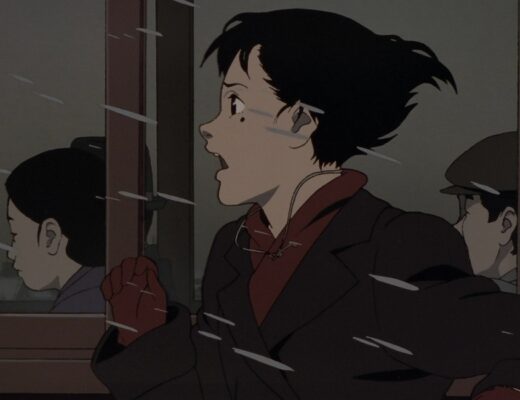The parallels between Martin Scorsese’s Shutter Island and Christopher Nolan’s much-anticipated Inception form a fascinating Siamese twin. Overlapping themes of familial fissures and regret make up the connective tissue, while Leonardo DiCaprio, playing traumatized archetypes battling haunted visions of violence, pumps the beating heart necessary to offset each’s brand of genre-centric escapism. These fever dreams are not about conjoining memories, they’re about splitting them apart: Shutter Island is razor-sharp in its Noir aesthetics, slicing an emotional artery of fragmented memory that bleeds until the frame runs cold, while Inception coldly destroys from within, gradually eating away at the memories of its protagonist until all that’s left are faded shades of love and devotion. In this sense, Inception watches the looping camera reel of one man’s life erode, minute by minute, highlighting the shattering moments of secrecy and torment lingering in the darkness of his mind. Shutter Island may be the more devastating and overall cohesive work, but Inception takes a far more difficult and thrilling route, reaching similarly tragic ends.
An ambiguous border between dreams and reality plays a big role here, enabling Nolan to construct whole cities, destroy mountains, and defy gravity. Expert thief and manipulator Dom Cobb (DiCaprio) traverses this fluid no man’s land with keen precision, maneuvering through the unconscious minds of high-profile targets to steal their thoughts for his employers. Cobb’s crack team of dream thieves, made up of his loyal second-in-command Arthur (Joseph Gordon-Levitt), young and talented “Architect” Ariadne (Ellen Page), and shape-shifting “Forger” Eames (Tom Hardy), are iconic genre conventions rather than characters. For better or worse, they serve as warning signs of Cobb’s disintegrating consciousness — and as Cobb’s ex-wife Mal (Marion Cotillard) continues to pop up in the dream world, each supporting character shivers with anticipated dread. Mal is a tumor vehemently spreading without remorse, infecting Cobb and impairing his ability to separate reality from a lucid state. All of these entities converge in an ambitious, dream-within-a-dream-within-a-dream structure that finds Cobb working with a Japanese businessman (Ken Watanabe) to corrupt the mind of an energy mogul (Cillian Murphy). The result is a fantastic jaunt through multiple layers of possibility, all folded in on each other with great skill by Nolan.
However, the extensive narrative landscape and mythology explored here often become Inception‘s greatest hurdle, notably during many lengthy exposition scenes. Characters elaborate and explain the rules, requirements, and taboos of entering and experiencing the dream world. These conversations water-log a great deal of Inception; many critics have rightly noted just how plodding some of these scenes can be, yet Nolan’s verboseness engenders essential information with regard to Cobb’s shifting interior conflict. In one particularly impressive sequence, Ariadne follows Cobb into his own dream world, witnessing the deeply rooted personal traumas that haunt him. Nolan constructs the sequence around a descending elevator set-piece, where every floor represents a different memory of Cobb’s guilt: A day at the beach, a tragic anniversary, and a quiet conversation. This makes for a devastating trifecta, and one of the only times (if not the only time) Inception‘s formalism conveys insight into a character without relying heavily on dialogue. It’s no surprise the ramifications of this sequence visually impact the film as it progresses.
If Inception uses its heist-film formula to help frame the ambitious elements at play, it also sees iconography as a buffer for Cobb’s personal and often reckless attempts at redemption. A criminal on the run from American authorities, Cobb is willing to do anything and everything to clear his name and return home to his children. This simple motivation turns complex in the dream world because every other character exists merely to give Cobb this opportunity. During the film’s final act, when Cobb and his team populate the aforementioned triptych of layered dreams, Nolan effortlessly transitions back and forth between haunting fits of slow motion and palpitating action sequences that exemplify the extreme sacrifice of these characters. The sheer workload drains them of their dimensionality, but each remains completely devoted to solving Cobb’s deeply rooted psychological issues and leavening the power they have over him. This motif comes to a brilliant head when Arthur battles armed men in a gravity-defying brawl, and again when he regroups, spinning the remaining dreamers into a spider’s web of electrical cords. Here Nolan achieves a great balance of action and imagination, and his impeccable pacing superbly conveys the limitless possibilities and dangers of the dream world he’s created.
Nolan juxtaposes his intricate narrative with Wally Pfister’s starkly cold cinematography and Hans Zimmer’s booming score, but Cobb’s suffering and DiCaprio’s corresponding facial expressions are always the director’s primary focus. While Inception isn’t the masterpiece some have claimed it to be, it is a thrilling genre piece masking a dynamic character study. Cobb’s guilt remains tangible in every scene, connecting the other aesthetic devices to a desperate and fruitless human need to keep self-inflicted demons at bay. Nolan achieves this dichotomy of visual power and psychological verve when Cobb enters the first layer of the dream world only to have a freight train careen down a Los Angeles city street and literally t-bone his car. It’s one of the most powerful moments in the film, and representative of Nolan’s desire to contrast kinetic movement with sledgehammered symbolism. This all leads to the crux of Nolan’s thematic intent with Inception: Framing the haunting destruction of a relationship within an epic action film structure. Whether you envision Inception as bravura Hollywood entertainment or ambitious failure, it’s hard to ignore Nolan’s potent examination of a marriage disillusioned by selfishness, dissolved by doubt, and reconstructed through a lens of regret. The rain-drenched train sequence best represents this collision of pathos and action film conventions.
During the film’s twisty final act, Inception brings Cobb full circle, making good on the visual allusions and clues established in the opening torrent of dialogue. Nolan can’t help but leave the viewer with a somewhat ambiguous ploy in the final moments, but no matter the interpretation of Cobb’s final decision, Inception successfully merges spectacle with feeling — a study of sacrifice and pain — creating a lasting vision of a man living on the razor’s edge of his own reality. And like the tortured U.S. Marshall he played in Shutter Island, DiCaprio brilliantly personifies this type of ravaging human dilemma. Inception, while never ideologically transcendent or narratively seamless, remains a sprawling labyrinth of intuitive action and reaction, where desperate decisions magnify the consequences permanently taking root in our consciousness, haunting the psyche from one life to the next.







